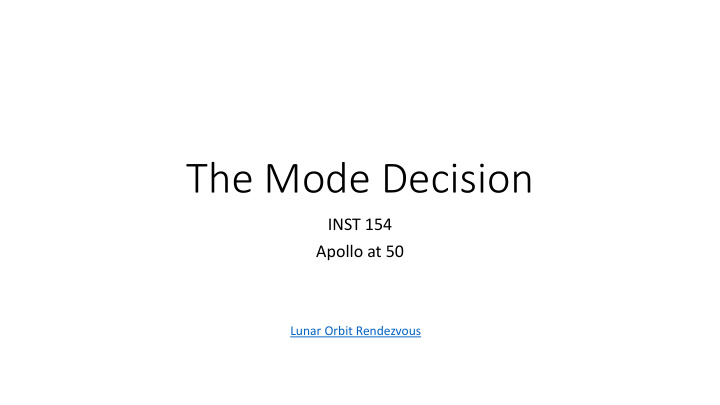



The Mode Decision INST 154 Apollo at 50 Lunar Orbit Rendezvous
Four Bad Ideas • Direct Ascent • Required an enormous rocket and made the landing much more difficult • Earth Orbit Rendezvous, then Direct Ascent • Required salvo launches and made the landing much more difficult • Lunar Orbit Rendezvous • Rendezvous failure at the moon would be fatal • Lunar Surface Rendezvous • Navigation errors on landing would be fatal
The Michoud Assembly Facility
Lunar Surface Rendezvous
EOR/Direct Ascent vs. Lunar Orbit Rendezvous
“Halfway to Anywhere” Apollo Lunar Landing Mission Symposium, 1966
Advantages and Disadvantages of LOR • Pro • Specialized lander can be optimized for that purpose • Separate vehicles can be developed and tested in parallel • Use of fewer launch vehicles reduces cost and risk • Con • Rendezvous had never been tested • Lander would not provide adequate shielding from a solar flare • Increased development cost for second crewed vehicle
Radiation Hazard Stubbs et al., Interplanetary Conditions During the Apollo Missions, 2012
Dramatis Personae • Robert C. (“Bob”) Seamans • D. Brainerd Holmes • Joseph F. (“Joe”) Shea • John C. Houbolt • Thomas E. (“Tom”) Dolan • Werner Von Braun • Charles W. Frick • Maxime A. (“Max”) Faget • Jerome B. (“Jerry”) Wiesner • Nicholas E. Golovin
Timeline • Dolan’s company-funded MALLAR studies begin at Vought (1958) • RCA and STL awarded DARPA study contracts for SAINT (late 1958) • Dolan briefing at Langley (early 1960) • Seamans leaves RCA to join NASA (September 1960) • Lundin committee recommends EOR as the mission mode (June 1961) • Houbolt minority report to the Golovin Committee (October 1961) • Shea leaves STL to join NASA (December 1961) • Decision to build the Saturn V (January 1962) • First American manned orbital flight (February 1962) • NASA selects Lunar Orbit Rendezvous for Apollo (July 1962) • Lunar Module contract awarded to Grumman (November 1962)
Optimizing for the Short Term • Saturn V is to Mars as Saturn 1B is to the Moon • By not pursuing Nova, NASA failed to invest in human solar system exploration • Growth potential of the “Apollo system” was severely limited • Lunar Module science payload was initially a few hundred points • Incentives for Marshall Space Flight Center to agree to LOR • Workload balancing for payloads (later realized as Skylab and Lunar Rover) • Promise to consider autonomous resupply (never funded) • Offer to continue work on Nova launch vehicle after Apollo funding peak (not done)
Discussion Groups • Annis Podcast (Apollo: The Mode Decision”) • A detailed recounting of many aspects of the mode decision • Alesi Article (“Do We Want to Go To the Moon or Not?”) • The mode decision from the perspective of Lunar Orbit Rendezvous advocates • Houbolt Report (“Manned Lunar Landing Thtough the Use of LOR” • The minority report the Golovin Committee that Houbolt sent directly to Seamans • Cox Chapter 9 (“What Sonofabitch Thinks It Isn’t the Right Thing to Do?”) • A vivid description of the end game for the mode decision debate
Recommend
More recommend